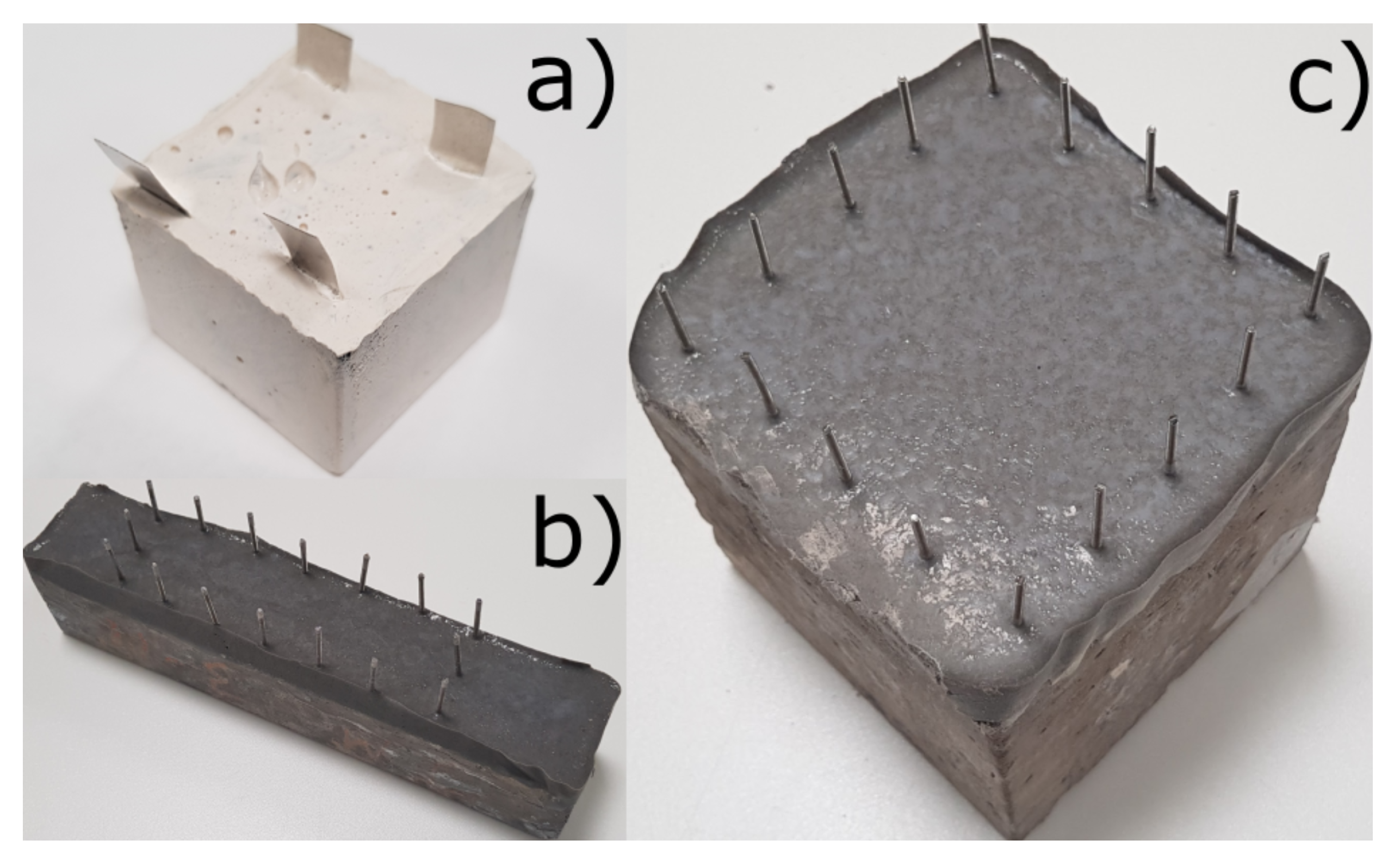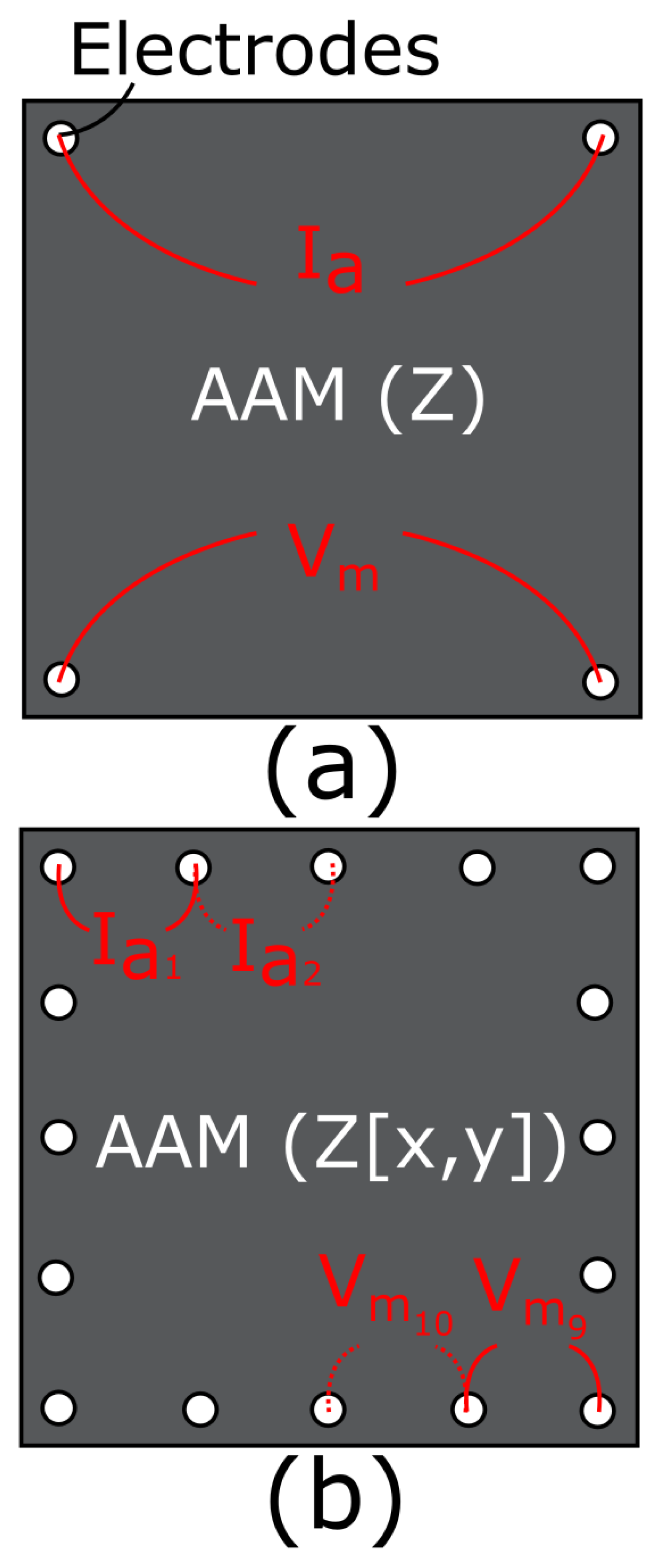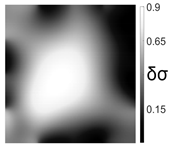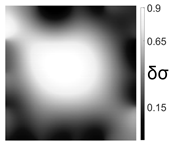ConcrEITS: An Electrical Impedance Interrogator for Concrete Damage Detection Using Self-Sensing Repairs
Abstract
:1. Introduction
2. Materials and Methods
2.1. Self-Sensing Repair Coatings for Concrete
2.1.1. Brief Theory
2.1.2. Mix Design
- Solid:liquid ratio
- NaSiO:NaOH ratio
- Additives
2.1.3. Application to Concrete
2.2. ConcrEITS: Design and Benchmarks
2.2.1. 4-Probe Impedance Measurement: Theory
2.2.2. ConcrEITS Instrument Design
2.2.3. ConcrEITS: Benchmarking
2.3. ConcrEITS: Implementing Tomography
2.3.1. Electrical Impedance Tomography: Theory
Forward Problem
Inverse Problem
2.3.2. ConcrEITS: Multiplexing Hardware Implementation
3. Results
3.1. Thermal Variations
3.2. Crack Detection and Location
4. Discussion
4.1. Analysing Results
4.2. Future Work
4.2.1. Improve Consistency of AAM Deployment
4.2.2. Up-Scaled Experiments
4.2.3. Increase Frequency of AC Excitation
4.2.4. Improve Measurement Accuracy
5. Conclusions
Author Contributions
Funding
Institutional Review Board Statement
Informed Consent Statement
Data Availability Statement
Acknowledgments
Conflicts of Interest
Abbreviations
| EITS | Electrical impedance tomography and spectroscopy |
| AAM | Alkali-activated material |
| ERT | Electrical resistance tomography |
| EIS | Electrical impedance spectroscopy |
| EIT | Electrical impedance tomography |
| USD | United states dollar |
| VDP | Van der Pauw |
| MCU | Micro-controller Unit |
| ADC | Analogue-to-digital converter |
| DAC | Digital-to-analogue converter |
| UART | Universal asynchronous receiver-transmitter |
| USB | Universal Serial Bus |
| RMSE | Root mean square error |
| CEM | Complete electrode model |
| EIDORS | Electrical impedance tomography and diffuse optical tomography reconstruction |
| PCB | Printed circuit board |
References
- Van Breugel, K. Societal Burden and Engineering Challenges of Ageing Infrastructure. Procedia Eng. 2017, 171, 53–63. [Google Scholar] [CrossRef]
- Kavitha, S.; Joseph Daniel, R.; Sumangala, K. High performance MEMS accelerometers for concrete SHM applications and comparison with COTS accelerometers. Mech. Syst. Signal Process. 2016, 66–67, 410–424. [Google Scholar] [CrossRef]
- Bassil, A.; Chapeleau, X.; Leduc, D.; Abraham, O. Concrete Crack Monitoring Using a Novel Strain Transfer Model for Distributed Fiber Optics Sensors. Sensors 2020, 20, 2220. [Google Scholar] [CrossRef] [Green Version]
- Aggelis, D.G.; Kordatos, E.Z.; Strantza, M.; Soulioti, D.V.; Matikas, T.E. NDT approach for characterization of subsurface cracks in concrete. Constr. Build. Mater. 2011, 25, 3089–3097. [Google Scholar] [CrossRef]
- Sreenath, S.; Malik, H.; Husnu, N.; Kalaichelavan, K. Assessment and Use of Unmanned Aerial Vehicle for Civil Structural Health Monitoring. Procedia Comput. Sci. 2020, 170, 656–663. [Google Scholar] [CrossRef]
- Jung, H.; Im, S.B.; An, Y.K. Probability-Based Concrete Carbonation Prediction Using On-Site Data. Appl. Sci. 2020, 10, 4330. [Google Scholar] [CrossRef]
- Konecny, P.; Lehner, P.; Vorechovska, D.; Somodikova, M.; Hornakova, M.; Rovnanikova, P. Evaluation of Durability-Related Field Inspection Data from Concrete Bridges Under Service. Arch. Metall. Mater. 2020, 65, 81–89. [Google Scholar] [CrossRef]
- Tyler Tallman, D.S. Structural health and condition monitoring via electrical impedance tomography in self-sensing materials: A review. Smart Mater. Struct. 2020, 29. [Google Scholar] [CrossRef]
- Yang, Y.; Jia, J. An Image Reconstruction Algorithm for Electrical Impedance Tomography Using Adaptive Group Sparsity Constraint. IEEE Trans. Instrum. Meas. 2017, 66, 2295–2305. [Google Scholar] [CrossRef] [Green Version]
- Polydorides, N.; Lionheart, W.R.B. A Matlab toolkit for three-dimensional electrical impedance tomography: A contribution to the Electrical Impedance and Diffuse Optical Reconstruction Software project. Meas. Sci. Technol. 2002, 13, 1871–1883. [Google Scholar] [CrossRef]
- Segura, C.C.; Osma, J.F. Portable Measurement Systems Based on Microcontrollers to Test Durability of Structures: Mini-Review. Front. Built Environ. 2020, 6, 201. [Google Scholar] [CrossRef]
- Steinberg, M.D.; Kassal, P.; Kereković, I.; Steinberg, I.M. A wireless potentiostat for mobile chemical sensing and biosensing. Talanta 2015, 143, 178–183. [Google Scholar] [CrossRef]
- Hallaji, M.; Seppänen, A.; Pour-Ghaz, M. Electrical impedance tomography-based sensing skin for quantitative imaging of damage in concrete. Smart Mater. Struct. 2014, 23, 085001. [Google Scholar] [CrossRef]
- Biondi, L.; Perry, M.; McAlorum, J.; Vlachakis, C.; Hamilton, A. Geopolymer-based moisture sensors for reinforced concrete health monitoring. Sens. Actuators Chem. 2020, 309. [Google Scholar] [CrossRef]
- Vlachakis, C.; Perry, M.; Biondi, L.; McAlorum, J. 3D printed temperature-sensing repairs for concrete structures. Addit. Manuf. 2020, 34. [Google Scholar] [CrossRef]
- McAlorum, J.; Perry, M.; Vlachakis, C.; Biondi, L.; Lavoie, B. Robotic spray coating of self-sensing metakaolin geopolymer for concrete monitoring. Autom. Constr. 2021, 121, 103415. [Google Scholar] [CrossRef]
- Provis, J.L.; Bernal, S.A. Geopolymers and Related Alkali-Activated Materials. Annu. Rev. Mater. Res. 2014, 44, 299–327. [Google Scholar] [CrossRef]
- Vlachakis, C.; Perry, M.; Biondi, L. Self-Sensing Alkali-Activated Materials: A Review. Minerals 2020, 10, 885. [Google Scholar] [CrossRef]
- Kozhukhova, N.; Teslya, A.; Alfimova, N.; Kozhukhova, M. Effect of Mixing Procedure and Chemical Composition on Physical and Mechanical Performance of Geopolymers. Mater. Sci. Forum 2021, 1017, 41–50. [Google Scholar] [CrossRef]
- Shahedan, N.; Abdullah, M.M.A.B.; Kamarudin, H.; Yahya, Z.; Razak, R.; Jamaludin, L. Reviews on the different sources materials to the geopolymer performance. Adv. Environ. Biol. 2013, 7, 3835–3842. [Google Scholar]
- Cai, J.; Pan, J.; Li, X.; Tan, J.; Li, J. Electrical resistivity of fly ash and metakaolin based geopolymers. Constr. Build. Mater. 2020, 234, 117868. [Google Scholar] [CrossRef]
- Duxson, P.; Fernández-Jiménez, A.; Provis, J.L.; Lukey, G.C.; Palomo, A.; van Deventer, J.S.J. Geopolymer technology: The current state of the art. J. Mater. Sci. 2007, 42, 2917–2933. [Google Scholar] [CrossRef]
- Kramar, S.; Šajna, A.; Ducman, V. Assessment of alkali activated mortars based on different precursors with regard to their suitability for concrete repair. Constr. Build. Mater. 2016, 124, 937–944. [Google Scholar] [CrossRef]
- Zhang, Z.; Wang, H.; Zhu, Y.; Reid, A.; Provis, J.L.; Bullen, F. Using fly ash to partially substitute metakaolin in geopolymer synthesis. Appl. Clay Sci. 2014, 88–89, 194–201. [Google Scholar] [CrossRef]
- Jaya, N.A.; Liew, Y.M.; Heah, C.Y.; Abdullah, M.M.A.B. Effect of solid-to-liquid ratios on metakaolin geopolymers. AIP Conf. Proc. 2018, 2045, 020099. [Google Scholar] [CrossRef]
- Albidah, A.; Alghannam, M.; Abbas, H.; Almusallam, T.; Al-Salloum, Y. Characteristics of metakaolin-based geopolymer concrete for different mix design parameters. J. Mater. Res. Technol. 2021, 10, 84–98. [Google Scholar] [CrossRef]
- Kuenzel, C.; Li, L.; Vandeperre, L.; Boccaccini, A.; Cheeseman, C. Influence of sand on the mechanical properties of metakaolin geopolymers. Constr. Build. Mater. 2014, 66, 442–446. [Google Scholar] [CrossRef]
- Li, X.; Rao, F.; Song, S.; Arroyo, M.A.C.; Lara, N.O.; Reyes, E.A.A. Effects of aggregates on the mechanical properties and microstructure of geothermal metakaolin based geopolymers. Results Phys. 2018, 11, 267–273. [Google Scholar] [CrossRef]
- Zanotti, C.; Borges, P.H.; Bhutta, A.; Banthia, N. Bond strength between concrete substrate and metakaolin geopolymer repair mortar: Effect of curing regime and PVA fiber reinforcement. Cem. Concr. Compos. 2017, 80, 307–316. [Google Scholar] [CrossRef]
- Biondi, L.; Perry, M.; Vlachakis, C.; Wu, Z.; Hamilton, A. Ambient cured fly ash geopolymer coatings for concrete. Materials 2019, 12, 923. [Google Scholar] [CrossRef] [Green Version]
- Changzhou Tian Yi Engineering Fiber Co. PVA Fibre Datasheet. Available online: http://www.tianyi-fiber.com/products/90 (accessed on 25 October 2021).
- Corva, D.M.; Hosseini, S.S.; Collins, F.; Adams, S.D.; Gates, W.P.; Kouzani, A.Z. Miniature Resistance Measurement Device for Structural Health Monitoring of Reinforced Concrete Infrastructure. Sensors 2020, 20, 4313. [Google Scholar] [CrossRef] [PubMed]
- Kaur, N.; Li, L.; Bhalla, S.; Xia, Y. A low-cost version of electro-mechanical impedance technique for damage detection in reinforced concrete structures using multiple piezo configurations. Adv. Struct. Eng. 2017, 20, 1247–1254. [Google Scholar] [CrossRef]
- Cosoli, G.; Mobili, A.; Tittarelli, F.; Revel, G.M.; Chiariotti, P. Electrical Resistivity and Electrical Impedance Measurement in Mortar and Concrete Elements: A Systematic Review. Appl. Sci. 2020, 10, 9152. [Google Scholar] [CrossRef]
- González-Díaz, G.; Pastor, D.; García-Hemme, E.; Montero, D.; García-Hernansanz, R.; Olea, J.; del Prado, A.; San Andrés, E.; Mártil, I. A robust method to determine the contact resistance using the van der Pauw set up. Measurement 2017, 98, 151–158. [Google Scholar] [CrossRef] [Green Version]
- Weiss, J.D. Generalization of the van der Pauw relationship derived from electrostatics. Solid-State Electron. 2011, 62, 123–127. [Google Scholar] [CrossRef]
- Microchip. ATXMEGA128a4u Data Sheet. Available online: https://www.microchip.com/en-us/product/ATxmega128A4U (accessed on 25 October 2021).
- Ammari, H. An Introduction to Mathematics of Emerging Biomedical Imaging; Springer: Berlin, Germany, 2008. [Google Scholar] [CrossRef] [Green Version]
- Vauhkonen, M.; Vadasz, D.; Karjalainen, P.; Somersalo, E.; Kaipio, J. Tikhonov regularization and prior information in electrical impedance tomography. IEEE Trans. Med. Imaging 1998, 17, 285–293. [Google Scholar] [CrossRef] [PubMed]








| Material | Wt% | Example (g) |
|---|---|---|
| Metakaolin | 32.02 | 273 |
| Fly ash | 3.17 | 27 |
| Sand (≤800 m) | 17.58 | 150 |
| PVA fibres (3 mm Length) | 0.35 | 3 |
| NaSiO solution | 31.18 | 266 |
| NaOH solution (10 M) | 15.70 | 134 |
| Ref. | Heat Location Image | Tomographic Reconstruction |
|---|---|---|
| T1 |  |  |
| T2 |  |  |
| T3 |  |  |
| Sample | Crack Image | Tomographic Reconstruction |
|---|---|---|
| SB1 |  |  |
| SB2 |  |  |
| SB3 |  |  |
| SB4 |  |  |
| SB5 |  |  |
| SB6 |  |  |
Publisher’s Note: MDPI stays neutral with regard to jurisdictional claims in published maps and institutional affiliations. |
© 2021 by the authors. Licensee MDPI, Basel, Switzerland. This article is an open access article distributed under the terms and conditions of the Creative Commons Attribution (CC BY) license (https://creativecommons.org/licenses/by/4.0/).
Share and Cite
McAlorum, J.; Perry, M.; Ward, A.C.; Vlachakis, C. ConcrEITS: An Electrical Impedance Interrogator for Concrete Damage Detection Using Self-Sensing Repairs. Sensors 2021, 21, 7081. https://doi.org/10.3390/s21217081
McAlorum J, Perry M, Ward AC, Vlachakis C. ConcrEITS: An Electrical Impedance Interrogator for Concrete Damage Detection Using Self-Sensing Repairs. Sensors. 2021; 21(21):7081. https://doi.org/10.3390/s21217081
Chicago/Turabian StyleMcAlorum, Jack, Marcus Perry, Andrew C. Ward, and Christos Vlachakis. 2021. "ConcrEITS: An Electrical Impedance Interrogator for Concrete Damage Detection Using Self-Sensing Repairs" Sensors 21, no. 21: 7081. https://doi.org/10.3390/s21217081
APA StyleMcAlorum, J., Perry, M., Ward, A. C., & Vlachakis, C. (2021). ConcrEITS: An Electrical Impedance Interrogator for Concrete Damage Detection Using Self-Sensing Repairs. Sensors, 21(21), 7081. https://doi.org/10.3390/s21217081






